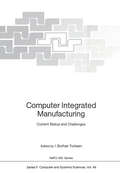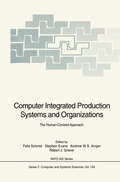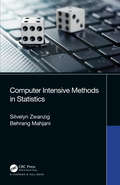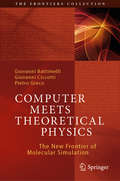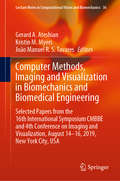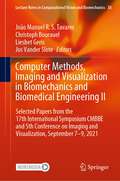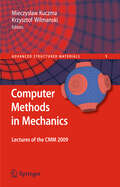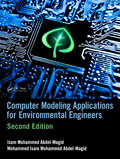- Table View
- List View
Computer Information Systems and Industrial Management: 14th IFIP TC 8 International Conference, CISIM 2015, Warsaw, Poland, September 24-26, 2015, Proceedings (Lecture Notes in Computer Science #9339)
by Khalid Saeed Wladyslaw HomendaThis book constitutes the proceedings of the 14th IFIP TC 8 International Conference on Computer Information Systems and Industrial Management, CISIM 2015, held in Warsaw, Poland, in September 2015.The 47 papers presented in this volume were carefully reviewed and selected from about 80 submissions. The main topics covered are biometrics, security systems, multimedia, classification and clustering with applications, and industrial management.
Computer Information Systems and Industrial Management: 13th IFIP TC 8 International Conference, CISIM 2014, Ho Chi Minh City, Vietnam, November 5-7, 2014, Proceedings (Lecture Notes in Computer Science #8838)
by Khalid Saeed Václav SnáselThis book constitutes the proceedings of the 13th IFIP TC 8 International Conference on Computer Information Systems and Industrial Management, CISIM 2014, held in Ho Chi Minh City, Vietnam, in November 2014. The 60 paper presented in this volume were carefully reviewed and selected from 98 submissions. They are organized in topical sections named: algorithms; biometrics and biometrics applications; data analysis and information retrieval; industrial management and other applications; modelling and optimization; networking; pattern recognition and image processing; and various aspects of computer security.
Computer Insecurity: Risking the System
by Steven M. FurnellWritten specifically for business managers. Emphasizes issues over technology.
Computer Integrated Manufacturing: Current Status and Challenges (NATO ASI Subseries F: #49)
by Kiyoji Asai Gunduz UlusoyThe Current state of expectations is that Computer Integrated Manufacturing (CIM) will ulti mately determine the industrial growth of world nations within the next few decades. Computer Aided Design (CAD), Computer Aided Manufacturing (CAM), Flexible Manufacturing Systems (FMS), Robotics together with Knowledge and Information Based Systems (KIBS) and Com munication Networks are expected to develop to a mature state to respond effectively to the managerial requirements of the factories of the future that are becoming highly integrated and complex. CIM represents a new production approach which will allow the factories to deliver a high variety of products at a low cost and with short production cycles. The new technologies for CIM are needed to develop manufacturing environments that are smarter, faster, close-cou pled, integrated, optimized, and flexible. Sophistication and a high degree of specialization in materials science, artificial intelligence, communications technology and knowledge-information science techniques are needed among others for the development of realizable and workable CIM systems that are capable of adjusting to volatile markets. CIM factories are to allow the production of a wide variety of similar products in small batches through standard but multi mission oriented designs that accommodate flexibility with specialized software.
Computer Integrated Production Systems and Organizations (NATO ASI Subseries F: #134)
by Felix Schmid Stephen Evans Andrew W. S. Ainger Robert J. GrieveThe Background to the Institute The NATO Advanced Study Institute (ASI) 'People and Computers - Applying an Anthropocentric Approach to Integrated Production Systems and Organisations' came about after the distribution of a NATO fact sheet to BruneI University, which described the funding of ASls. The 'embryonic' director of the ASI brought this opportunity to the attention of the group of people, (some at BruneI and some from outside), who were together responsible for the teaching and management of the course in Computer Integrated Manufacturing (CIM) in BruneI's Department of Manufacturing and Engineering Systems. This course had been conceived in 1986 and was envisaged as a vehicle for teaching manufacturing engineering students the technology of information integration through project work. While the original idea of the course had also included the organisational aspects of CIM, the human factors questions were not considered. This shortcoming was recognised and the trial run of the course in 1988 contained some lectures on 'people' issues. The course team were therefore well prepared and keen to explore the People, Organisation and Technology (POT) aspects of computer integration, as applied to industrial production. A context was proposed which would allow the inclusion of people from many different backgrounds and which would open up time and space for reflection. The proposal to organise a NATO ASI was therefore welcomed by all concerned.
Computer, Intelligent Computing and Education Technology
by Hsiang-Chuan Liu Wen-Pei Sung Wenli YaoThis proceedings set contains selected Computer, Information and Education Technology related papers from the 2014 International Conference on Computer, Intelligent Computing and Education Technology (CICET 2014), held March 27-28, 2014 in Hong Kong. The proceedings aims to provide a platform for researchers, engineers and academics as well as indu
Computer Intensive Methods in Control and Signal Processing: The Curse of Dimensionality
by Kevin Warwick Miroslav KarnyDue to the rapid increase in readily available computing power, a corre sponding increase in the complexity of problems being tackled has occurred in the field of systems as a whole. A plethora of new methods which can be used on the problems has also arisen with a constant desire to deal with more and more difficult applications. Unfortunately by increasing the ac curacy in models employed along with the use of appropriate algorithms with related features, the resultant necessary computations can often be of very high dimension. This brings with it a whole new breed of problem which has come to be known as "The Curse of Dimensionality" . The expression "Curse of Dimensionality" can be in fact traced back to Richard Bellman in the 1960's. However, it is only in the last few years that it has taken on a widespread practical significance although the term di mensionality does not have a unique precise meaning and is being used in a slightly different way in the context of algorithmic and stochastic complex ity theory or in every day engineering. In principle the dimensionality of a problem depends on three factors: on the engineering system (subject), on the concrete task to be solved and on the available resources. A system is of high dimension if it contains a lot of elements/variables and/or the rela tionship/connection between the elements/variables is complicated.
Computer Intensive Methods in Statistics
by Silvelyn Zwanzig Behrang MahjaniThis textbook gives an overview of statistical methods that have been developed during the last years due to increasing computer use, including random number generators, Monte Carlo methods, Markov Chain Monte Carlo (MCMC) methods, Bootstrap, EM algorithms, SIMEX, variable selection, density estimators, kernel estimators, orthogonal and local polynomial estimators, wavelet estimators, splines, and model assessment. Computer Intensive Methods in Statistics is written for students at graduate level, but can also be used by practitioners. Features Presents the main ideas of computer-intensive statistical methods Gives the algorithms for all the methods Uses various plots and illustrations for explaining the main ideas Features the theoretical backgrounds of the main methods. Includes R codes for the methods and examples Silvelyn Zwanzig is an Associate Professor for Mathematical Statistics at Uppsala University. She studied Mathematics at the Humboldt- University in Berlin. Before coming to Sweden, she was Assistant Professor at the University of Hamburg in Germany. She received her Ph.D. in Mathematics at the Academy of Sciences of the GDR. Since 1991, she has taught Statistics for undergraduate and graduate students. Her research interests have moved from theoretical statistics to computer intensive statistics. Behrang Mahjani is a postdoctoral fellow with a Ph.D. in Scientific Computing with a focus on Computational Statistics, from Uppsala University, Sweden. He joined the Seaver Autism Center for Research and Treatment at the Icahn School of Medicine at Mount Sinai, New York, in September 2017 and was formerly a postdoctoral fellow at the Karolinska Institutet, Stockholm, Sweden. His research is focused on solving large-scale problems through statistical and computational methods.
Computer Intensive Methods in Statistics
by Silvelyn Zwanzig Behrang MahjaniThis textbook gives an overview of statistical methods that have been developed during the last years due to increasing computer use, including random number generators, Monte Carlo methods, Markov Chain Monte Carlo (MCMC) methods, Bootstrap, EM algorithms, SIMEX, variable selection, density estimators, kernel estimators, orthogonal and local polynomial estimators, wavelet estimators, splines, and model assessment. Computer Intensive Methods in Statistics is written for students at graduate level, but can also be used by practitioners. Features Presents the main ideas of computer-intensive statistical methods Gives the algorithms for all the methods Uses various plots and illustrations for explaining the main ideas Features the theoretical backgrounds of the main methods. Includes R codes for the methods and examples Silvelyn Zwanzig is an Associate Professor for Mathematical Statistics at Uppsala University. She studied Mathematics at the Humboldt- University in Berlin. Before coming to Sweden, she was Assistant Professor at the University of Hamburg in Germany. She received her Ph.D. in Mathematics at the Academy of Sciences of the GDR. Since 1991, she has taught Statistics for undergraduate and graduate students. Her research interests have moved from theoretical statistics to computer intensive statistics. Behrang Mahjani is a postdoctoral fellow with a Ph.D. in Scientific Computing with a focus on Computational Statistics, from Uppsala University, Sweden. He joined the Seaver Autism Center for Research and Treatment at the Icahn School of Medicine at Mount Sinai, New York, in September 2017 and was formerly a postdoctoral fellow at the Karolinska Institutet, Stockholm, Sweden. His research is focused on solving large-scale problems through statistical and computational methods.
Computer Intrusion Detection and Network Monitoring: A Statistical Viewpoint (Information Science and Statistics)
by David J. MarchetteThis book covers the basic statistical and analytical techniques of computer intrusion detection. It is the first to present a data-centered approach to these problems. It begins with a description of the basics of TCP/IP, followed by chapters dealing with network traffic analysis, network monitoring for intrusion detection, host based intrusion detection, and computer viruses and other malicious code.
Computer Keyboard Overview Diagram (large print)
by RnibThis diagram shows an overview of a computer keyboard layout in blocks. Keys which are immediately adjacent to each other are shown as a block of continuous texture or colour. There is a locator dot shown, which will be at the top left of the page when the image is the right way up. In the bottom left of the image is the biggest block, block 1 the main keyboard (alphabet, numbers and punctuation keys). Up from block 1 is block 2, the top line of keys (escape key, function keys). To the right of block 2 is block 3, the three system keys. Down from here is block 4, the six pack. Down again is block 5, the arrow cursor keys. On the far right of the image is block 6, the number pad. At the bottom of the page is a short key which names the blocks.
Computer Keyboard Overview Diagram (UEB contracted)
by RnibThis diagram shows an overview of a computer keyboard layout in blocks. Keys which are immediately adjacent to each other are shown as a block of continuous texture or colour. There is a locator dot shown, which will be at the top left of the page when the image is the right way up. In the bottom left of the image is the biggest block, block 1 the main keyboard (alphabet, numbers and punctuation keys). Up from block 1 is block 2, the top line of keys (escape key, function keys). To the right of block 2 is block 3, the three system keys. Down from here is block 4, the six pack. Down again is block 5, the arrow cursor keys. On the far right of the image is block 6, the number pad. At the bottom of the page is a short key which names the blocks.
Computer Keyboard Overview Diagram (UEB uncontracted)
by RnibThis diagram shows an overview of a computer keyboard layout in blocks. Keys which are immediately adjacent to each other are shown as a block of continuous texture or colour. There is a locator dot shown, which will be at the top left of the page when the image is the right way up. In the bottom left of the image is the biggest block, block 1 the main keyboard (alphabet, numbers and punctuation keys). Up from block 1 is block 2, the top line of keys (escape key, function keys). To the right of block 2 is block 3, the three system keys. Down from here is block 4, the six pack. Down again is block 5, the arrow cursor keys. On the far right of the image is block 6, the number pad. At the bottom of the page is a short key which names the blocks.
Computer Law (PDF)
by Chris ReedThis edition is fully updated to reflect the Digital Economy Act 2010 and changes to consumer protection law at EU level including the Unfair Commercial Practices Directive. Analysis of recent case law is also incorporated including, amongst others, the series of trade mark actions against eBay and copyrights suits against Google as well as the implications for IT contracts of BSkyB Ltd v HP Enterprise Services UK Ltd. All chapters have been revised to take into account the rapid evolution of the ways in which we consume, generate, store and exchange information, such as cloud computing, off-shoring and Web 2.0.
Computer Logic: Design Principles and Applications
by John Y. HsuThis book provides the reader with the key concepts and techniques of modern digital logic design and applications. This concise treatment provides essential development and explanations for both classical and modern topics. The modern topics include unicode, unipolar transistors, copper technology, flash memory, HDL, verilog and logic simulation software tools. Also covered are combinatorial logic circuits and transistor circuits. It will be an essential resource for computer scientists, logic circuit designers and computer engineers.
Computer Mathematics: 9th Asian Symposium (ASCM2009), Fukuoka, December 2009, 10th Asian Symposium (ASCM2012), Beijing, October 2012, Contributed Papers and Invited Talks
by Ruyong Feng Wen-Shin Lee Yosuke SatoThis book covers original research and the latest advances in symbolic, algebraic and geometric computation; computational methods for differential and difference equations, symbolic-numerical computation; mathematics software design and implementation; and scientific and engineering applications based on features, invited talks, special sessions and contributed papers presented at the 9th (in Fukuoka, Japan in 2009) and 10th (in Beijing China in 2012) Asian Symposium on Computer Mathematics (ASCM). Thirty selected and refereed articles in the book present the conference participants’ ideas and views on researching mathematics using computers.
Computer Mathematics: 8th Asian Symposium, ASCM 2007, Singapore, December 15-17, 2007, Revised and Invited Papers (Lecture Notes in Computer Science #5081)
by Deepak KapurThis book constitutes thoroughly refereed post-conference proceedings of the 8th Asian Symposium on Computer Mathematics, ASCM 2007, held in Singapore in December 2007. The 22 revised full papers and 5 revised poster papers presented together with 3 invited lectures were carefully selected during two rounds of reviewing and improvement from 65 submissions. The papers are organized in topical sections on algorithms and implementations, numerical methods and applications, cryptology, and computational logic.
Computer-Mediated Social Networking: First International Conference, ICCMSN 2008, Dunedin, New Zealand, June 11-13, 2009, Revised Selected Papers (Lecture Notes in Computer Science #5322)
by Maryam Purvis Bastin Tony Roy SavarimuthuThis volume constitutes the revised selected papers of the First International Conference, ICCMSN 2008, held in Dunedin, New Zealand, in June 2009. The 19 revised papers presented were carefully reviewed and selected from a total of 34 submissions. The papers are organized in topical sections on virtual environments and second life; knowledge networks and learning in social networks; applications and integration of social networking systems as well as social concepts associated with social networking.
Computer Meets Theoretical Physics: The New Frontier of Molecular Simulation (The Frontiers Collection)
by Giovanni Battimelli Giovanni Ciccotti Pietro GrecoThis book provides a vivid account of the early history of molecular simulation, a new frontier for our understanding of matter that was opened when the demands of theoretical physicists were met by the availability of the modern computers. Since their inception, electronic computers have enormously increased their performance, thus making possible the unprecedented technological revolution that characterizes our present times. This obvious technological advancement has brought with it a silent scientific revolution in the practice of theoretical physics. In particular, in the physics of matter it has opened up a direct route from the microscopic physical laws to observable phenomena. One can now study the time evolution of systems composed of millions of molecules, and simulate the behaviour of macroscopic materials and actually predict their properties. Molecular simulation has provided a new theoretical and conceptual tool that physicists could only dream of when the foundations of statistical mechanics were laid. Molecular simulation has undergone impressive development, both in the size of the scientific community involved and in the range and scope of its applications. It has become the ubiquitous workhorse for investigating the nature of complex condensed matter systems in physics, chemistry, materials and the life sciences. Yet these developments remain largely unknown outside the inner circles of practitioners, and they have so far never been described for a wider public. The main objective of this book is therefore to offer a reasonably comprehensive reconstruction of the early history of molecular simulation addressed to an audience of both scientists and interested non-scientists, describing the scientific and personal trajectories of the main protagonists and discussing the deep conceptual innovations that their work produced.
Computer Methods for Analysis of Mixed-Mode Switching Circuits
by Fei Yuan Ajoy OpalComputer Methods for Analysis of Mixed-Mode Switching Circuits provides an in-depth treatment of the principles and implementation details of computer methods and numerical algorithms for analysis of mixed-mode switching circuits. Major topics include: -Computer-oriented formulation of mixed-mode switching circuits, -Network functions of linear and nonlinear time-varying systems, -Numerical Laplace inversion based integration algorithms and inconsistent initial conditions, -Time domain analysis of periodically switched linear and nonlinear circuits including response, sensitivity, noise, clock jitter, and statistical quantities, -Time domain analysis of circuits with internally controlled switches and over-sampled sigma-delta modulators, -Tellegen's theorem, frequency reversal theorem, and transfer function theorem of periodically switched linear circuits and their applications, -Frequency domain analysis of periodically switched linear and nonlinear circuits including response, sensitivity, group delay, noise, and statistical quantities.
Computer Methods, Imaging and Visualization in Biomechanics and Biomedical Engineering: Selected Papers from the 16th International Symposium CMBBE and 4th Conference on Imaging and Visualization, August 14-16, 2019, New York City, USA (Lecture Notes in Computational Vision and Biomechanics #36)
by João Manuel R. S. Tavares Gerard A. Ateshian Kristin M. MyersThis book gathers selected, extended and revised contributions to the 16th International Symposium on Computer Methods in Biomechanics and Biomedical Engineering, and the 4th Conference on Imaging and Visualization (CMBBE 2019), held on August 14-16, 2019, in New York City, USA. It reports on cutting-edge models and algorithms for studying various tissues and organs in normal and pathological conditions; innovative imaging and visualization techniques; and the latest diagnostic tools. Further topics addressed include: numerical methods, machine learning approaches, FEM models, and high-resolution imaging and real-time visualization methods applied for biomedical purposes. Given the scope of its coverage, the book provides graduate students and researchers with a timely and insightful snapshot of the latest research and current challenges in biomedical engineering, computational biomechanics and biological imaging, as well as a source of inspiration for future research and cross-disciplinary collaborations.
Computer Methods, Imaging and Visualization in Biomechanics and Biomedical Engineering II: Selected Papers from the 17th International Symposium CMBBE and 5th Conference on Imaging and Visualization, September 7-9, 2021 (Lecture Notes in Computational Vision and Biomechanics #38)
by João Manuel R. S. Tavares Christoph Bourauel Liesbet Geris Jos Vander SloteThis book gathers selected, extended and revised contributions to the 17th International Symposium on Computer Methods in Biomechanics and Biomedical Engineering and the 5th Conference on Imaging and Visualization (CMBBE 2021), held online on September 7-9, 2021, from Bonn, Germany. It reports on cutting-edge models, algorithms and imaging techniques for studying cells, tissues and organs in normal and pathological conditions. It covers numerical and machine learning methods, finite element modeling and virtual reality techniques, applied to understand biomechanics of movement, fluid and soft tissue biomechanics. It also reports on related advances in rehabilitation, surgery and diagnosis. All in all, this book offers a timely snapshot of the latest research and current challenges at the interface between biomedical engineering, computational biomechanics and biological imaging. Thus, it is expected to provide a source of inspiration for future research and cross-disciplinary collaborations.
Computer Methods in Mechanics: Lectures of the CMM 2009 (Advanced Structured Materials #1)
by Mieczyslaw Kuczma Krzysztof WilmanskiProminent scientists present the latest achievements in computational methods and mechanics in this book. These lectures were held at the CMM 2009 conference.
Computer Modeling Applications for Environmental Engineers
by Isam Mohammed Abdel-Magid Ahmed Mohammed Isam Mohammed Abdel-MagidComputer Modeling Applications for Environmental Engineers in its second edition incorporates changes and introduces new concepts using Visual Basic.NET, a programming language chosen for its ease of comprehensive usage. This book offers a complete understanding of the basic principles of environmental engineering and integrates new sections that address Noise Pollution and Abatement and municipal solid-waste problem solving, financing of waste facilities, and the engineering of treatment methods that address sanitary landfill, biochemical processes, and combustion and energy recovery. Its practical approach serves to aid in the teaching of environmental engineering unit operations and processes design and demonstrates effective problem-solving practices that facilitate self-teaching. A vital reference for students and professional sanitary and environmental engineers this work also serves as a stand-alone problem-solving text with well-defined, real-work examples and explanations.



